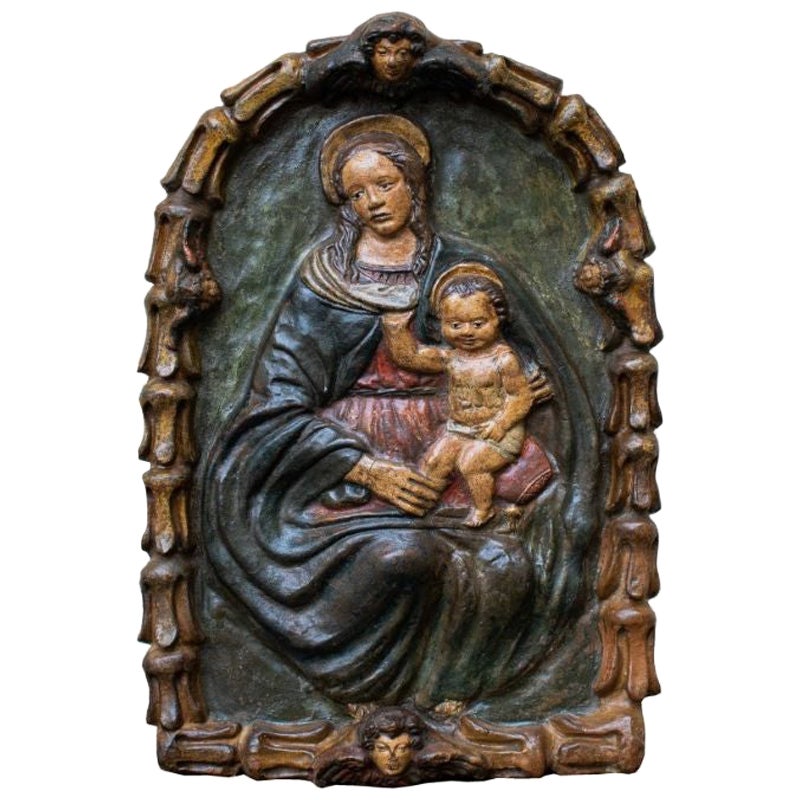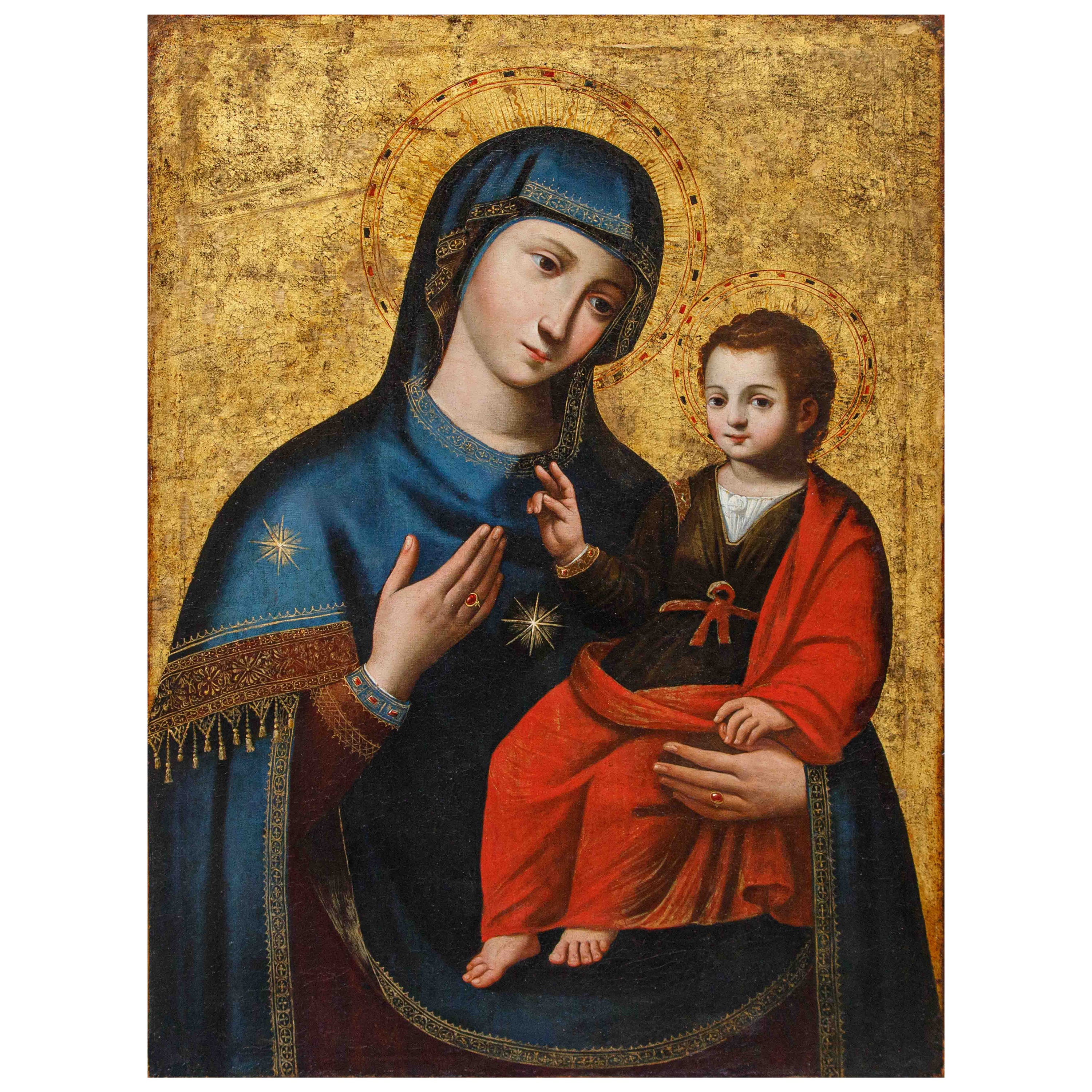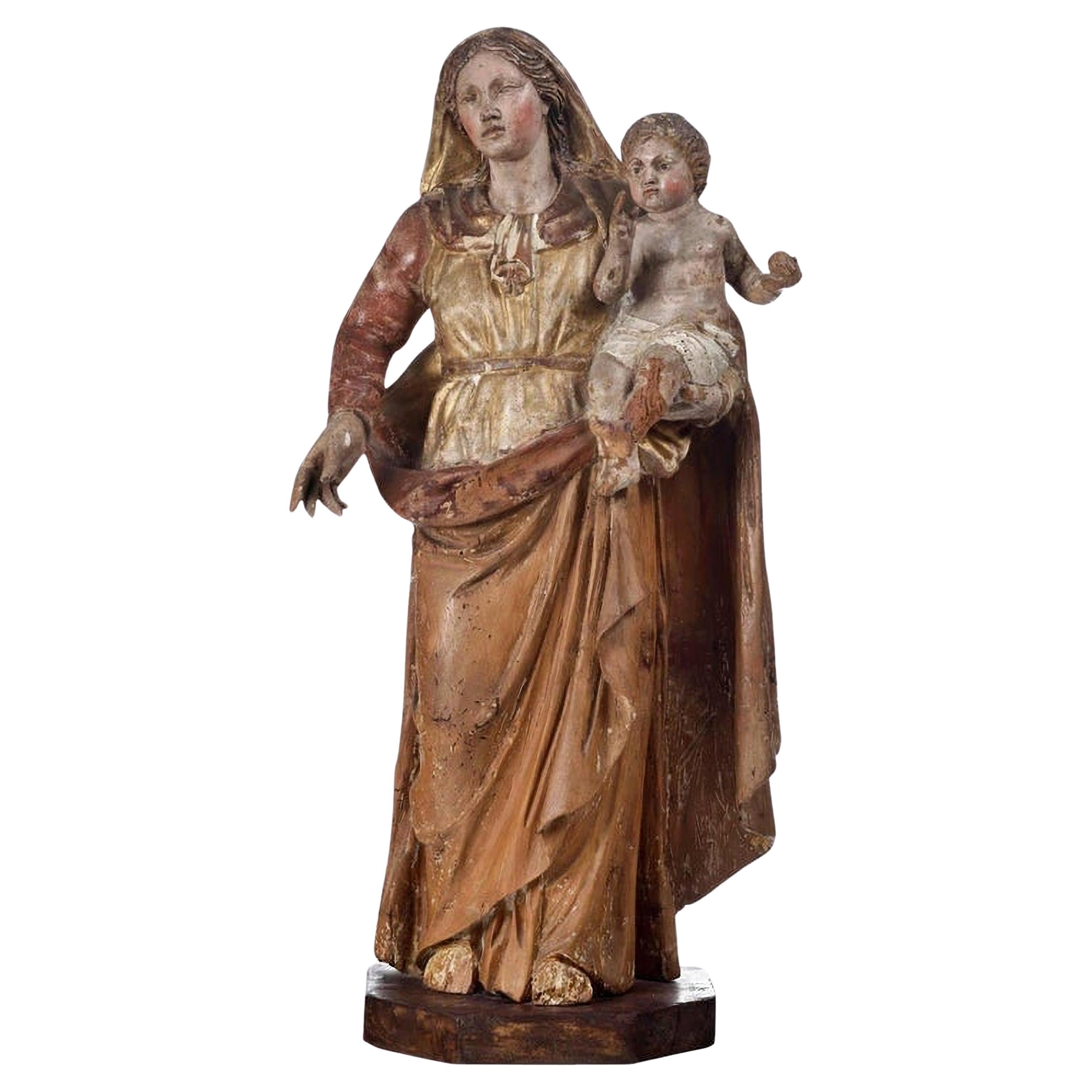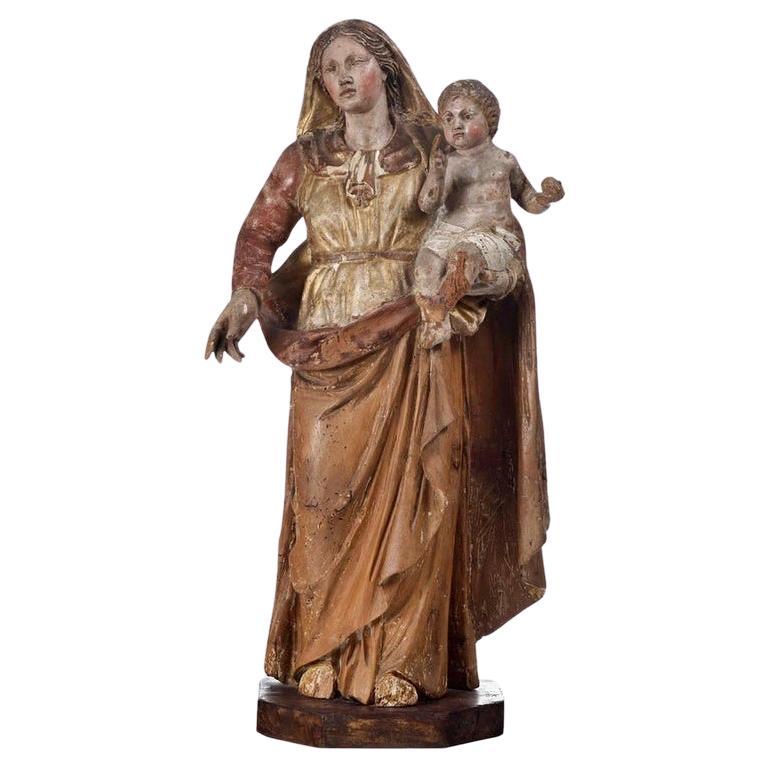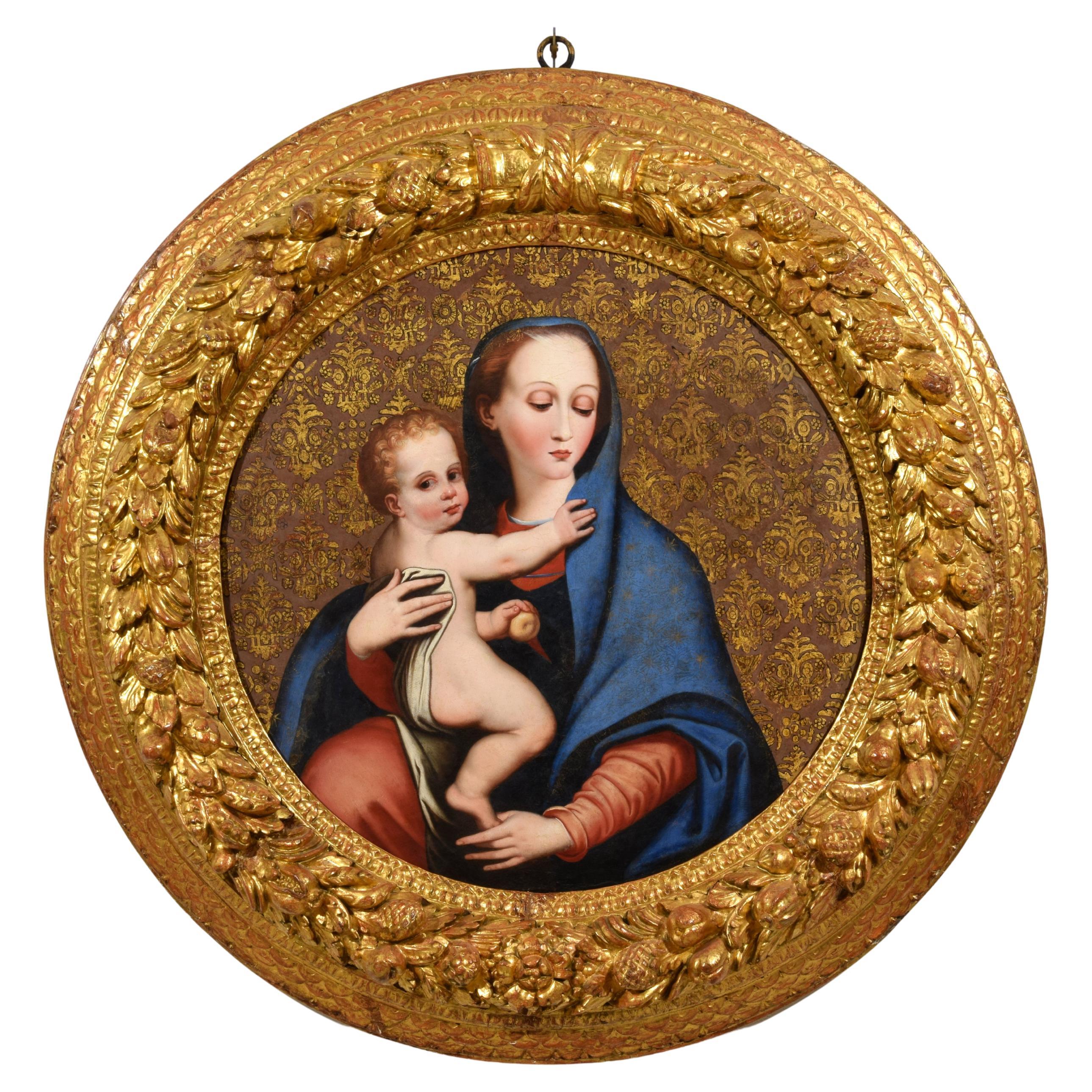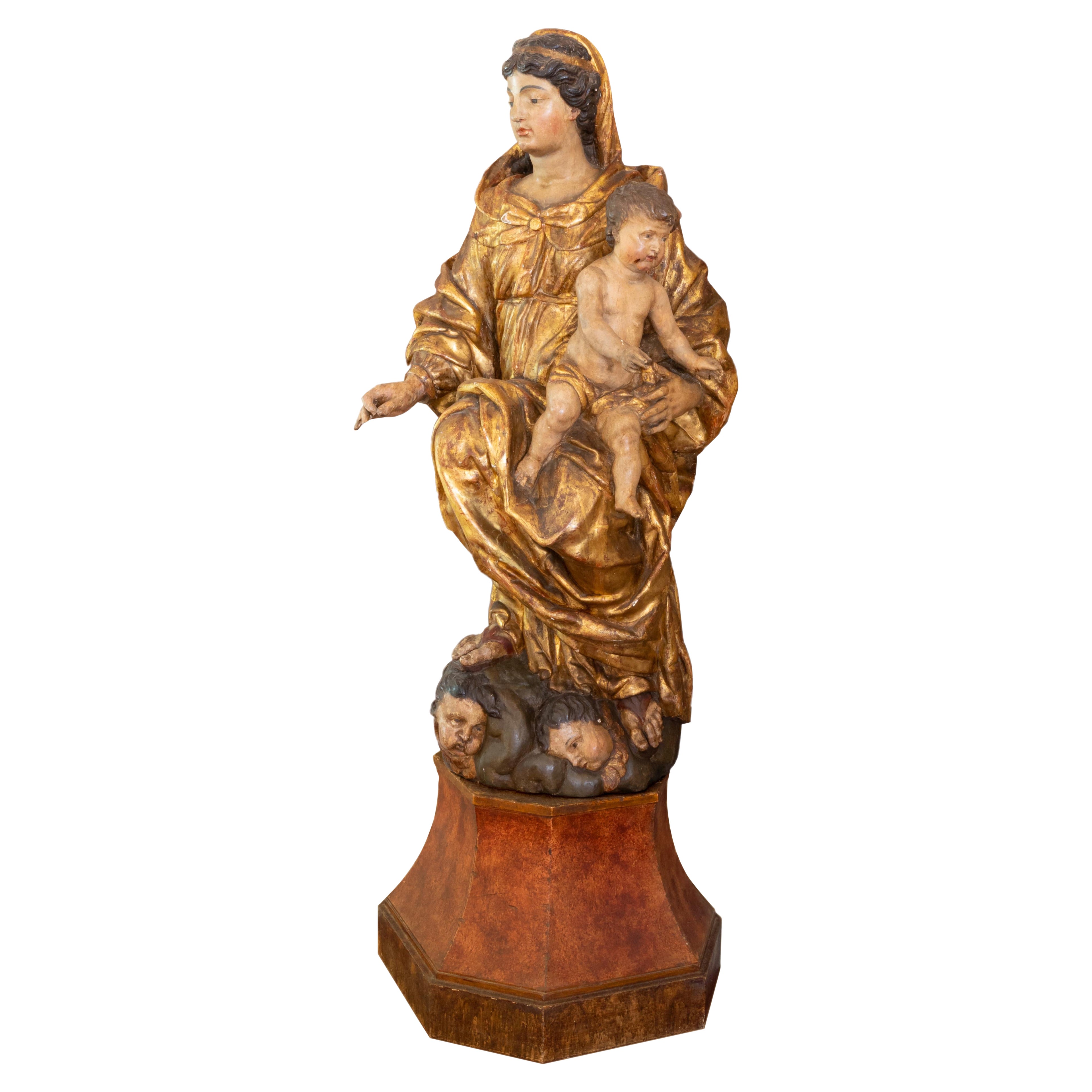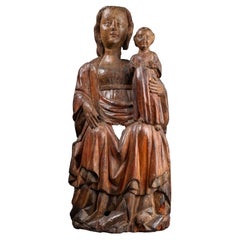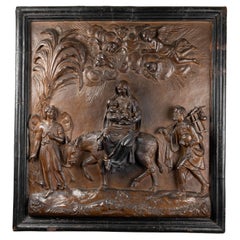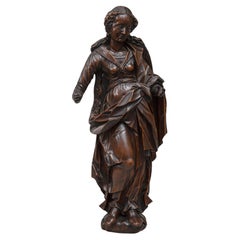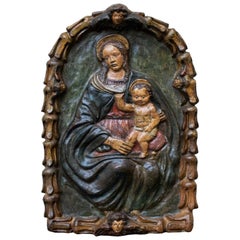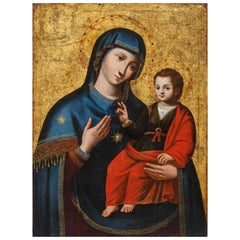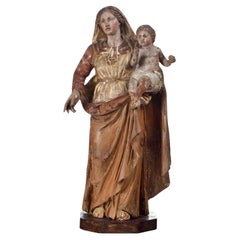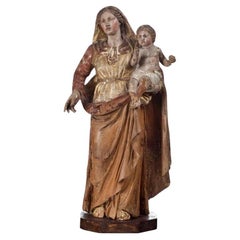Items Similar to Attributed to Domenico di Paris - Madonna and The Child, 15th century
Want more images or videos?
Request additional images or videos from the seller
1 of 6
Attributed to Domenico di Paris - Madonna and The Child, 15th century
$69,468.91
£51,480.28
€58,000
CA$94,838.26
A$105,503.68
CHF 55,306.35
MX$1,289,229.21
NOK 704,257.38
SEK 662,960.89
DKK 441,606.90
Shipping
Retrieving quote...The 1stDibs Promise:
Authenticity Guarantee,
Money-Back Guarantee,
24-Hour Cancellation
About the Item
Attributed to Domenico di Paris, also called Domenico del Cavallo ( Monselice, documented in Ferrara between 1442 and 1501)
Madonna and The Child
Polychromed and gilded Stucco
47,5 x 37,5 cm
Exhibitions :
- Il tesoro d’Italia, a cura di Vittorio Sgarbi, Expo 2015, 22 maggio-31 ottobre 2015, Silvana Editoriale, pp. 162-163, Emilia n. 4
Modeled in half-length, The virgin, tenderly holding her Son, raise from an angel’s head, against a blue starry background.
The Child is clutching his mother’s veil with one hand, his other at her back. The Mary’s thick mantle and robe and lighter veil envelop her and offer protection to the Child, who entwines the veil with his hands.
This Madonna is portrayed with pleasing, youthful features; she tenderly support the Child Jesus and lightly cradles His foot which she holds between two fingers; a graceful, touching iconographic invention.
The artist was clearly interested in a naturalistic rendering of the subject as seen in the painted details of the hair and faces and the careful modeling of the drapery.
The outstanding original fifteenth-century polychrome rendition is the most fascinating element of this haut-relief in stucco. The highly refined painterly details are rendered with touching graphic skill, as in the facial features and in the refined decoration of the Virgin’s veil and the clothes of the Child as in the angel’s wings. This elegant relief is quintessential example of works that Renaissance Italian artists produced for domestic devotion.
So popular were images of the Madonna and Child that artists sought to vary and polish their composition. It is a forceful representation of the subject, but two very different qualities, intimacy and modest scale, are what make this kind of relief so successful.
This stucco shows an intimate and beautiful composition, a peculiar domestic feel, an appealing naturalism that suggest it was inspired by an illustrious model; the mastery of the technique indicate an artist familiar with the refined elegance of Tuscans workshops.
The iconography of the Madonna holding Christ’s foot and of Christ grasping his mother’s veil, popular in Renaissance Italian panel painting as well as sculpture, derives from Byzantine icons. But it appears that Luca della Robbia have first essayed the half-length Madonna holding a Child in a work in stucco (Musée Jacquemart-André, Paris) about 1430. With regard to the molding, as Enzo Carli pointed out, it is of a model retraceable to a well-known typology, diffused through numerous replicas made both by the master himself and others, of the Corsini Madonna by Luca della Robbia, dateable to the fifth or sixth decade of the fifteenth century.
Especially the impetus and quick manners of the Child, that bear witness to the as yet fresh experiences of Masaccio and Donatello, confirms that this stucco may be inspired by Luca Della Robbia prototype.
The back of this stucco is solid and flat as the Friedrichstein Virgin, cast from the same mold, of the Virgin and Child in a Niche, of the type known as the “Bliss Madonna”: these are in the Metropolitan Museum of Art, New York and in the Museum of Fine Arts, Boston, and are also datable to the same period.
The Buffalo Virgin, which is distinguished by more detailed modeling, more accurate technical execution (see, for example, the way that the back of the panel is finished with chamfered edges to the borders) and a more delicate palette in the glazing, could be an entirely autograph work (its high quality and its claim to this status has been endorsed by Avery 1976 and Pope-Hennessy 1980, after seeing it with their own eyes in April 1976), while the Berlin version could be a replica delegated to an assistant – such as Luca’s young nephew Andrea della Robbia (Florence 1435 - 1525), who was documented as working in Luca’s studio from 1451 onwards. Alternatively, acknowledging the initial experimental phase of Della Robbian art, it might be that the Buffalo Virgin was executed by Luca some time later, with a perfected technique and revisions to some of the details of the modelling. However, it is not impossible that different destinations may have accounted for such variations. Nevertheless, there can be no doubt about Luca’s responsibility for this touching model, which clearly demonstrates the “familiar, pleasing, but suspended and silent humanity” that distinguishes the master’s best work towards the middle of the century.
« L’accentuata toscanità » (The accentuated Tuscan character) of our stucco relief indicate that the author was familiar with the iconographical innovations proposed in Florence; meanwhile this stucco shows some significant affinities, especially in the polychromy, with the refined artistic atmosphere of the este court.
As Giancarlo Gentilini first suggested this work could be by the hand of an artist active in Ferrara as Antonio di Cristoforo (Gentilini, 2008). In fact The centres north of the Arno, in which plastic art were practiced, were Bologna and Padua, the latter being the town in which Donatello, during a sojourn lasting over ten years, succeeded in firmly establishing the tradition of the Florentines. The restricted circle of pupils and other collaborators adapted Donatello’s style in a more or less successful personal manner, and so established it in many provinces, both in the immediate neighborhood of Padua and further afield. Ferrara, a close neighbor of Padua, naturally could not remain independent of the effect of the great Florentine’s long years of work in the vicinity. Although very few sculptures dating from the first decades of the century have been brought to light in the city of Este, too few to give any clear impression of the existence of a native school of carvers, from the beginning of the ‘forties we are confronted with one tangible personality bearing the name of Niccoló Baroncelli. This artist was a native of Florence and, according to Vasari, had been a pupil of Brunelleschi. His existing works indicate a long apprenticeship with Donatello.
Baroncelli, who, through his engagement in the service of the Estensian Court, remained in Ferrara till his death in 1453, must have been an active worker, but unfortunately, the greater part of his work has been lost. We found evidence in them of the extent to which his gifted pupil and son-in-law, Domenico di Paris, a Padouan by birth, obtained his artistic education from him. Domenico, documente as « maestro de figure de terra et de metallo » (maître des sculptures en terre-cuite et métal) played a leading part in Ferrarese sculpture during the second half of 15th century. Born in Monselice, he was formed in Padua, where he familiarized with the works of Donatello. Around 1442 Domenico di Paris is documented In Ferrara, together with his brother in law, the Florentine sculptor Niccoló Baroncelli who had been invited to the city to create the equestrian monument of Borso d’Este (destroyed in 1796) and a set of five bronze sculptures for the cathedral. After Baroncelli’s death in 1453, Domenico completed all the commissions. In 1467 Domenico was engaged as « intarsiator lignaminis » in the execution of the ceiling of the « Camera Superioris » of palazzo Schifanoia.
The major ducal commissions of bronze monuments in honor of Niccoló III (1443-1451) and Corso (1451_1457) brought three artists to Ferrara that « combined the Florence of the humanists and the Padua of the antiquarians, profoundly influencing Ferrarese art in the direction of Donatello: Antonio di Cristoforo, Niccoló Baroncelli and Domenico di Paris » (cit. permanent exhibition in the recently re-opened Palazzo Schifanoia, 2020).
In the present relief representing the Virgin and the Child, the influence of the Paduan works of Donatello is filtered by a softer vision partly indebted to Florentine models; the style is far from the expressionist irregularities of his contemporaries working in Ferrara.
A very similar relief from the Dogliani Collection, of inferior quality, show the same composition of our relief. Dated 1480, this timeline is indicative of the production of our stucco as well.
The decorative finesse, the richness of the polychrome and the naturalistic attention of this Virgin and The Child show affinities with the Virtues of the Stucco room in Schifanoia, last documented work of Domenico di Paris.
The accentuated tuscan character and the stylistic affinities with the reliefs in Palazzo Schifanoia, as also the remarkable similarities with some sculptures attributed to Baroncelli, led the art historian Paola Ranzolin to attribute this work to Domenico di Paris and to publish it in the exhibition curated by Vittorio Sgarbi in 2015 (International expo - « Il Tesoro d’Italia ») where a selection of treasures of the Italian artistic patrimoine were presented according to a regional approach aimed to enhancing the richness and individuality of the different provinces of the Peninsula. This stucco is one of the 27 works selected to represent the evolution of the rich artistic heritage of Emilia Romagna.
- Dimensions:Height: 18.71 in (47.5 cm)Width: 14.77 in (37.5 cm)Depth: 1.19 in (3 cm)
- Style:Renaissance (Of the Period)
- Materials and Techniques:Stucco,Polychromed
- Place of Origin:
- Period:
- Date of Manufacture:15th century
- Condition:Wear consistent with age and use.
- Seller Location:Bruxelles, BE
- Reference Number:1stDibs: LU6666239212722
About the Seller
5.0
Vetted Professional Seller
Every seller passes strict standards for authenticity and reliability
1stDibs seller since 2022
15 sales on 1stDibs
Typical response time: 2 hours
- ShippingRetrieving quote...Shipping from: Bruxelles, Belgium
- Return Policy
Authenticity Guarantee
In the unlikely event there’s an issue with an item’s authenticity, contact us within 1 year for a full refund. DetailsMoney-Back Guarantee
If your item is not as described, is damaged in transit, or does not arrive, contact us within 7 days for a full refund. Details24-Hour Cancellation
You have a 24-hour grace period in which to reconsider your purchase, with no questions asked.Vetted Professional Sellers
Our world-class sellers must adhere to strict standards for service and quality, maintaining the integrity of our listings.Price-Match Guarantee
If you find that a seller listed the same item for a lower price elsewhere, we’ll match it.Trusted Global Delivery
Our best-in-class carrier network provides specialized shipping options worldwide, including custom delivery.More From This Seller
View AllVirgin and the Child, Mosan Region, Second Half of 13th Century
Located in Bruxelles, BE
A polychrome sculpture depicting the Virgin and the Child
Mosan region, second half of 13th century
Polychrome wood
73 x 29 X 12 cm
Provenance :
Former Belgian private collection from the beginning of the 20th century
This remarkable early artwork portrays the Enthroned Virgin and Child, also known as Sedes Sapientiae, which translates to the 'Seat of Wisdom...
Category
Antique 15th Century and Earlier Belgian Medieval Figurative Sculptures
Materials
Wood
Renaissance Marble Relief - Emilia Romagna, 1470-80
Located in Bruxelles, BE
Renaissance Marble Relief
Emilia Romagna, Faenza ? 1470-80
H 30,2 x L 33 x P 3,5 cm
The carved marble relief depicts the Virgin accompanied by a winge...
Category
Antique 15th Century and Earlier Italian Renaissance Figurative Sculptures
Materials
Marble
Large Terracotta Relief - Lombardy, First Half of 17th Century
Located in Bruxelles, BE
Large Terracotta relief of the flight into Egypt
Lombardy, first half of 17th century
Painted terracotta
91 x 85 x 11,5 cm
This event in the early life of Christ is recounted i...
Category
Antique 17th Century Italian Baroque Figurative Sculptures
Materials
Terracotta
$62,303 Sale Price
20% Off
Statuette of the Virgin, South German circa 1600
Located in Bruxelles, BE
Statuette of the Virgin
South-German, circa 1600
sculpted wood
circa 1600
(right arm restored)
52 cm
Category
Antique 17th Century German Renaissance Religious Items
Materials
Wood
Bolognese School of the 16th Century - Mummy of Saint Catherine of Bologna
Located in Bruxelles, BE
Bolognese School of the 16th Century
Mummy of Saint Catherine of Bologna
Oil on Panel
20,5 x 7 x 0,8 cm
This rare painting depicts Saint Catherine of Bologna as a mummy, housed in a ...
Category
Antique 16th Century Italian Renaissance Paintings
Materials
Wood, Giltwood
$3,353 Sale Price
20% Off
Free Shipping
Renaissance relief - Italy, probably Rome, 16th century
Located in Bruxelles, BE
Renaissance relief depicting two female figures dressed in a chiton
Italy, probably Rome, 16th century
Marble, wooden frame (provenance label on the back)
28 x 20 x 5 cm
This beau...
Category
Antique 16th Century Italian Renaissance Wall-mounted Sculptures
Materials
Marble
You May Also Like
17th Century Madonna with Child from the Impruneta Tondo Polychrome Terracotta
Located in Milan, IT
Tuscan school, 17th century
Madonna with Child - from the Impruneta Tondo
Measures: Polychrome terracotta, 65 x 46 x 10 cm
This polychrome terracotta relief, gently jutting...
Category
Antique 17th Century Italian Abstract Sculptures
Materials
Terracotta
16th century Madonna and Child Oil on canvas with gold background
Located in Milan, IT
XVII Century
Madonna and Child
Oil on canvas, 116 x 83 cm
The canvas under consideration depicts the Icon of the Most Holy Virgin Consoled, or more correctly Consoler of the Affl...
Category
Antique 17th Century Decorative Art
Materials
Canvas
Wooden Madonna with Child Baroque Art Italy 17th Century with Export Certificate
Located in Madrid, ES
A Wooden Madonna with child Baroque art, Southern Italy, 17th century.
Measure: H: 71cm
Good condition for the time.
With Export Certificate to USA.
Category
Antique Early 17th Century Italian Baroque Figurative Sculptures
Materials
Wood
$4,695 Sale Price
20% Off
Wooden Madonna with Child Baroque Art Italy 17th Century with Export Certificate
Located in Madrid, ES
A Wooden Madonna with child Baroque art, Southern Italy, 17th century.
Measure: H: 71cm
Good condition for the time.
With Export Certificate to USA.
Category
Antique Early 17th Century Italian Baroque Figurative Sculptures
Materials
Wood
$4,695 Sale Price
20% Off
17th Century, Italian Oil on Panel Painting Depicting Madonna della Purità
Located in IT
17th Century, Italian Oil on Panel Painting Depicting Madonna della Purità
The painting, executed in oil on a circular wooden panel and presented in an imposing carved and gilded wo...
Category
Antique 17th Century Italian Renaissance Paintings
Materials
Wood, Giltwood
Italian Baroque Religious Madonna and Child Sculpture, 18th Century
Located in Lisbon, PT
An 18th-century Italian sculpture of a draped Madonna, masterfully carved in polychrome and gilded wood.
The Virgin, gracefully veiled, holding the infant Jesus on her lap with a st...
Category
Antique 18th Century Italian Baroque Figurative Sculptures
Materials
Gold Leaf
$23,581 Sale Price
32% Off
More Ways To Browse
Italian Renaissance 15th Century
Buffalo Head
Italian Della Robbia
Antique Byzantine Icon
Byzantine Relief
Jesus And Mary Figure Sculpture
Italian Bronze Equestrian Sculptures
Luca Della Robbia
Avery Scales
Antique Avery Scales
After Della Robbia
Andrea Della Robbia
Antique Demilune Chest
Antique French Music Box
Antique Gien
Antique Metal Wall Shelves
Antique Pine Bureau
Antique Pot Rack
